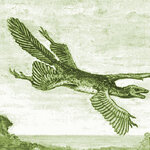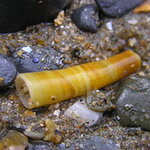Contradictions and puzzles surround Prototaxites, organisms that existed during the Late Silurian to Late Devonian periods-- approximately 420-370 million years ago (ma). The existing fossils resemble tree trunks, yet they are from a time before trees existed. The stable carbon isotope values are similar to those of fungi, but the fossils do not display structures usually found in fungi. Plant-like polymers have been found in the fossils, but nutritional evidence supports heterotrophy, which is not commonly found in plants.
Since the first fossil of Prototaxites was described in 1859,…
Paleontology

A new commentary just published in the Proceedings of the National Academy of Sciences claims that more evidence is mounting that birds did not evolve from ground-dwelling theropod dinosaurs and challenging decades of accepted theories about the evolution of flight.
The weight of the evidence is now suggesting that not only did birds not descend from dinosaurs, but that some species now believed to be dinosaurs may have descended from birds, according John Ruben, a professor of zoology at Oregon State University who authored the PNAS commentary.
"We're finally breaking out of the conventional…
Writing in the latest issue of Science, researchers say they have identified the vibrant colors that adorned Anchiornis huxleyi, a feathered dinosaur extinct for 150 million years. The discovery may add weight to the idea that dinosaurs first evolved feathers not for flight but for purposes such as sexual selection.
Researchers closely examined 29 feather samples from the dinosaur and measured melanosomes (cellular organelles that contain melanin) within the feathers. A statistical analysis of how those melanosomes compared to the types known to create particular colors in living birds…
A 60-million-year-old relative of crocodiles named Cerrejonisuchus improcerus ("small crocodile from Cerrejon") was likely a food source for Titanoboa, the largest snake the world has ever known, says a new study published this week in the Journal Vertebrate Paleontology.
Researchers from Smithsonian Tropical Research Institute in Panama and paleontologists from the Florida Museum of Natural History found fossils of the new species of ancient crocodile in the Cerrejon Formation in northern Colombia. The site, one of the world's largest open-pit coal mines, also yielded skeletons of the giant…

If you like to try your hand at new things and have a penchant for the old or shiny.. no not your dating taste, but something earthier... you may want to consider a trip to Vermillion Bluffs near the town of Princeton, British Columbia. Princeton has long been known as a hotbed of paleobotany.
During the middle Eocene, 45-50 m.y.a., a number of freshwater lakes appeared in an arc extending from Smithers, through the modern Cariboo, to Kamloops, the Nicola Valley, Princeton, and Republic, WA. The lakes likely formed after a period of faulting produced a number of basins, called grabens…
Contrary to the claims of most paleontologists, researchers from University of Kansas and Northeastern University in China say that bird flight evolved up in the trees, and flight tests of a model of the four-winged gliding raptor called microraptor lend credence to their theory.
"The controversy was that these animals couldn't spread their hind-wings to glide," said Burnham. "But we've been able to articulate the bones in their hip socket to show that they could fly." The new flight model created by Martin and Burnham comes directly from a skeleton composed of casts of the original…
More than a hundred years after its discovery, the limbs and vertebrae of a fossil have been pulled off the shelf at the American Museum of Natural History to revise the view of early carnivore lifestyles. Carnivores—currently a diverse group of mostly meat-eating mammals like bears, cats, raccoons, seals, and hyenas—had been considered arboreal in their early evolutionary history.
But now that the skeleton of 'Miacis' uintensis has been unpacked from its matrix of sandstone, it is clear that some early carnivores were built to walk on the ground at least part of the time. The new research…
A group of paleontologists has discovered a venomous, birdlike raptor that thrived some 128 million years ago in China, and is the first reported venomous ancestor in the lineage that leads to modern birds. The discovery is documented this week in the early edition of the Proceedings of the National Academy of Sciences.
The dromaeosaur or raptor, Sinornithosaurus (Chinese-bird-lizard), is a close relative to Velociraptor. It lived in prehistoric forests of northeastern China that were filled with a diverse assemblage of animals including other primitive birds and dinosaurs.
"This is an…
Paleontologists have unearthed a previously unknown Theropod dinosaur from a fossil bone bed in northern New Mexico, settling a debate about early dinosaur evolution, and hinting at how dinosaurs spread across the supercontinent Pangaea.
The description of the new species, named Tawa after the Hopi word for the Puebloan sun god, appears in the Dec. 10 issue of the journal Science.
The fossil bones of several individuals were recovered, but the type specimen is a nearly complete skeleton of a juvenile that stood about 28 inches (70 cm) tall at the hips and was about 6 feet (2 meters)…

The fossil exposures of the Lincoln Creek Formation, southern Olympic Peninsula, near the town of Porter, Washington consist of tuffaceous siltstone and sandstone with concretionary beds throughout. They are slightly older than originally thought, coming in around 37 million-years, straddling the Eocene-Oligocene border. The site has produced several dozen different species of molluscs, including the elusive tusk shell, and is well known for crabs.
Here a wee modern tusk shell or scaphopod sits in the sand. The whitish aragonitic shells of scaphopods are…
